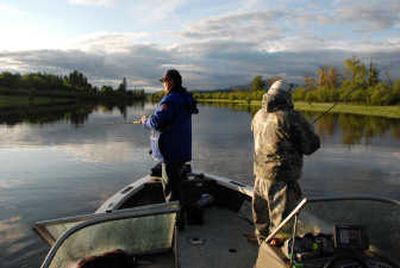Pike explosion lures anglers, researchers

Near the peak of high water this month, I found myself on the Pend Oreille River with two awesomely efficient predators:
The northern pike and Seth Burrill.
Preparation is essential for being on the water with either of them.
Many bass anglers casting spinner baits along the river shores in recent years have been surprised by the savage strikes of a newcomer species three or four times the size of a good largemouth. The new bully on the block has a rack of teeth that could leave the uninitiated sleepless, if not bloody.
Similarly, more than a few anglers invited onto Burrill’s boat have been surprised to learn that fishing can be an extreme sport. Bring full survival gear, and prepare to stay until the secrets of catching the targeted species are unlocked, regardless of the elements or time of day.
Burrill doesn’t flee from storms, he endures them.
Food and water are consumed only during boat runs between fishing spots.
Burrill doesn’t wish for the right lure. He probably has it in one of the 144 tackle boxes on board.
As he told me the first time I joined him – an 18-degree winter day at Priest Lake – “There’s no top or heater or anything. This is a tough-guy boat.”
Burrill is the perfect man to follow in pursuit of the biggest news on the Pend Oreille.
Northern pike, a non-native species, have been in the river for years. But researchers are verifying that pike are exploding in size and numbers, much as they did in the Lake Coeur d’Alene system in the 1980s after first being documented in 1972.
As state size records were being set nearly every year, anglers at the time were saying Coeur d’Alene was the best pike fishing short of the Northwest Territories before the fishery peaked, backed off and found its equilibrium.
A similar boom appears to be under way from the Lower Clark Fork River, through parts of Lake Pend Oreille and downstream in the Pend Oreille River from Idaho and well into Washington.
“We had a suspicion they were coming,” said Joe Maroney, fisheries manager for the Kalispel Tribe. “They’d been upstream in Noxon and Albani reservoirs for a long time. But it was only five years ago that we found some pike here along the reservation (near Cusick), so we initiated a study.”
The research continues, including electro-shocking and diet sampling. A radio telemetry study was enacted in 2005 to follow pike movements. Here’s a summary of the findings so far:
“Northern pike are rapidly filling a new niche in the Pend Oreille River.
“Some pike have been weighed to 25 pounds.
“At this stage, the pike are feeding mostly on pumpkinseed sunfish, plus yellow perch and peamouth.
“Previous studies had found no pike in our waters, and we found only a dozen or so in the first year of our study,” Maroney said. “But by the next year, we were finding pretty decent numbers.”
Similar to the Lake Coeur d’Alene experience, the booming pike are showing growth rates among the highest for the species anywhere in fisheries literature, he said.
“These pike are putting on 5 to 7 pounds a year,” he said. “Generally, this can only happen when a new species moves into a new habitat, finds a niche and exploits it. Growth rates are through the roof.”
This phenomenon won’t last forever, he predicted. “Eventually they will peak and come down to a plateau,” he said. “But for now, they’re still in the boom phase.”
Maroney has told bass anglers the tribe is as interested as anyone in protecting the area’s bass fishery.
“We’re trying to keep an eye on the pike because we’re heavily invested in bass,” he said. “The tribe has a bass hatchery, with about 30 people involved with our hatchery and fisheries staff. Our bass program is a huge success because of our habitat, and it’s important to the tribe.
“A lot of bass anglers on the river have fished major tournaments around the West and they say some of their best days ever have been on the Pend Oreille River.”
But Maroney admits he has no crystal ball.
“I’ve told the bass clubs that bass aren’t showing much in the pike diet at this time, but we’re just on the verge of this population and we don’t know how it will change, what’s going to happen or when. We do know that pike are very piscivorous – they eat a lot of fish.
“Right now they’re providing a pretty good sport fishery.”
Seth Burrill can verify that.
In May, just before the flood waters riled the Pend Oreille River, Burrill and a companion hooked and released more than 30 northerns in a single day.
A week later when I joined Burrill, the water was colder, murkier and several feet higher. Yet Burrill still landed nine pike and triggered another dozen strikes, mostly with paddle tail swimbaits.
“This radical change of conditions has affected them,” he said. “They’re not as aggressive today. But that will change.”
Fly-casting an 8-inch long pattern of white and yellow rabbit fur and red saddle hackles on a floating line, I was able to land three pike while fishing part time at the back end of Burrill’s boat.
“Fly patterns can be deadly on pike,” acknowledged Burrill, who embraces all hook-and-line fishing tactics.
Regardless of the type of rod he’s casting, Burrill is a highly evolved fish-catching predator. Two cold downpours in an open boat couldn’t slow his casting tempo or dampen his enthusiasm.
At sunset, when Angler’s Xperience cameraman Randy Johnson said his fingers were so cold he couldn’t handle a rod or a camera, Burrill put his hand – seemingly impervious to cold – to his buddy’s cheek and said, “Feel the heat.”
“He’s a fishing machine,” Johnson said, slumped in his seat as Burrill continued to cast.